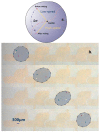EWOD Chip with Micro-Barrier Electrode for Simultaneous Enhanced Mixing during Transportation
- PMID: 37631640
- PMCID: PMC10459807
- DOI: 10.3390/s23167102
EWOD Chip with Micro-Barrier Electrode for Simultaneous Enhanced Mixing during Transportation
Abstract
Digital microfluidic platforms have been extensively studied in biology. However, achieving efficient mixing of macromolecules in microscale, low Reynolds number fluids remains a major challenge. To address this challenge, this study presents a novel design solution based on dielectric electro-wetting (EWOD) by optimizing the geometry of the transport electrode. The new design integrates micro-barriers on the electrodes to generate vortex currents that promote mixing during droplet transport. This design solution requires only two activation signals, minimizing the number of pins required. The mixing performance of the new design was evaluated by analyzing the degree of mixing inside the droplet and quantifying the motion of the internal particles. In addition, the rapid mixing capability of the new platform was demonstrated by successfully mixing the sorbitol solution with the detection solution and detecting the resulting reaction products. The experimental results show that the transfer electrode with a micro-barrier enables rapid mixing of liquids with a six-fold increase in mixing efficiency, making it ideal for the development of EWOD devices.
Keywords: EWOD; micro-barrier; microfluidic; mixing.
Conflict of interest statement
The authors declare no conflict of interest.
Figures









Similar articles
-
Design of a Hand-Held and Battery-Operated Digital Microfluidic Device Using EWOD for Lab-on-a-Chip Applications.Micromachines (Basel). 2021 Sep 1;12(9):1065. doi: 10.3390/mi12091065. Micromachines (Basel). 2021. PMID: 34577709 Free PMC article.
-
On-chip organic synthesis enabled using an engine-and-cargo system in an electrowetting-on-dielectric digital microfluidic device.Lab Chip. 2019 Sep 10;19(18):3054-3064. doi: 10.1039/c9lc00428a. Lab Chip. 2019. PMID: 31373597
-
Electrochemical detection on electrowetting-on-dielectric digital microfluidic chip.Talanta. 2011 Jun 15;84(5):1384-9. doi: 10.1016/j.talanta.2011.03.073. Epub 2011 Apr 28. Talanta. 2011. PMID: 21641456
-
Research progress of electrode shapes in EWOD-based digital microfluidics.RSC Adv. 2023 Jun 5;13(25):16815-16827. doi: 10.1039/d3ra01817b. eCollection 2023 Jun 5. RSC Adv. 2023. PMID: 37283873 Free PMC article. Review.
-
Applications of electrowetting-on-dielectric (EWOD) technology for droplet digital PCR.Biomicrofluidics. 2020 Dec 4;14(6):061503. doi: 10.1063/5.0021177. eCollection 2020 Nov. Biomicrofluidics. 2020. PMID: 33312327 Free PMC article. Review.
Cited by
-
On-Chip DNA Assembly via Dielectrophoresis.Micromachines (Basel). 2025 Jan 11;16(1):76. doi: 10.3390/mi16010076. Micromachines (Basel). 2025. PMID: 39858731 Free PMC article.
References
Grants and funding
LinkOut - more resources
Full Text Sources

